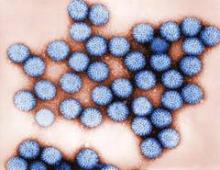Two large U.S.-based studies have found the risk of intussusception, a rare type of bowel obstruction in infants, to be elevated after rotavirus vaccination.
Concerns about intussusception risk date back to 1999, when a tetravalent rotavirus vaccine was withdrawn by its manufacturer after being shown to be associated with between 1 and 2 excess cases per 10,000 infants vaccinated.
Findings from clinical trials of newer pentavalent and monovalent vaccines, introduced in 2006 and 2008, respectively, showed no such excess intussusception risk. However, recent studies from Australia, Mexico, and Brazil have indicated that excess risk is associated with these newer vaccines as well, though to a far lesser degree than with the earlier vaccine.
The first of the new studies, published online Jan. 14 in the New England Journal of Medicine (doi: 10.1056/NEJMoal1303164), offers evidence for a slight but statistically significant increase in intussusception risk associated with use of Merck’s pentavalent vaccine, RV5 (RotaTeq).
For their research, Katherine Yih, Ph.D., of Harvard Medical School and the Harvard Pilgrim Health Care Institute, Boston, and her associates looked at data from more than 1.2 million doses of RV5. The Food and Drug Administration (FDA) sponsored the study, and data were derived from health plans included in the FDA’s Mini-Sentinel surveillance program.
Using data from 507,874 first doses and 1,277,556 total doses of RV5, Dr. Yih’s team found an excess risk of 1.5 cases per 100,000 within 21 days after the first dose (95% confidence interval, 0.2-3.2), with no further increases in risk seen after the second or third dose. This represents about one tenth of the excess risk seen with the first-generation vaccine.
Dr. Yih and her associates also looked at data from 103,098 doses of a monovalent vaccine, GlaxoSmithKline’s RV1 (Rotarix). Risk was seen as increased after the second dose. However, this study was insufficiently powered to demonstrate a statistically significant risk in association with the monovalent vaccine.
The team acknowledged that some missing chart information reduced the power and precision of their study.
A separate study, also published online Jan. 14 in the New England Journal of Medicine (doi: 10.1056/NEJMoa1311708), looked at data from 207,955 doses of the monovalent vaccine, identifying intussusception cases recorded within 7 days after a first or second dose.
The investigators, led by Eric Weintraub, of the Centers for Disease Control and Prevention (CDC) in Atlanta, found 5.3 excess cases over expected background rates per 100,000 infants vaccinated with two doses. The authors acknowledged that their findings of elevated risk could be due to chance, given the small number of cases seen in the study.
In the same study, Mr. Weintraub and his colleagues found no increase in risk associated with the pentavalent vaccine, for which there were data on 1,301,810 doses. However, they noted, the confidence intervals for this finding were wide.
The data used in Mr. Weintraub and colleagues’ study came from the Vaccine Safety Datalink surveillance program run by the CDC. The CDC program collects data from health care plans different from those used in the FDA’s program.
Mr. Weintraub and his associates acknowledged that other studies, including that of Dr. Yih and colleagues, had shown elevated risk associated with the pentavalent vaccine. The difference in results, the investigators wrote, might be attributable to different study methodologies, uncontrolled confounding, and varying background rates of intussusception in the study populations.
Mr. Weintraub’s study was funded by the CDC. Three of his coauthors reported commercial grant support from GlaxoSmithKline, Inviragen, Merck, and other companies. One of Dr. Yih’s coauthors disclosed being an employee and stockholder of Aetna, which participates in the Mini-Sentinel program.


